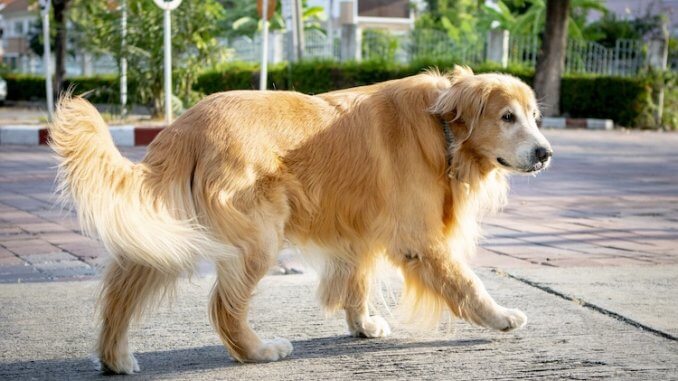
As a dog owner, we know you’d be lying if you said you’d never been whacked across the leg or in the face by a wagging tail!
If it was a long-haired dog, you probably got away unscathed, but if it was a Labrador, you probably considered a visit to the ER.
Some seasoned dog owners have probably also seen the “tail-of-destruction” when your dog is so excited they start knocking items off shelves by accident.
Despite the destruction they can cause, a dog’s tail is a vital part of their anatomy.
Crucial for canine-to-canine communication, it’s particularly helpful in letting owners know if their dog is sick.
In this article we dive into the world of dog tails and explore why they have them, how to understand different positions and why some dogs love to chase and chew them!
TABLE OF CONTENTS
1. Why Do Dogs Have Tails?

A dog’s tail is part of their anatomy and has muscles and bones. It can suffer trauma and its bones can also break.
It has many important functions and is not just there for its appearance.
Dogs use them for balance, but most importantly dogs use their tail to communicate.
Wagging and different positions let us know the emotional state of our dog. In turn we can manage situations when they are unable to. If we know our dog is getting stressed, we can remove them from the stimulus. If we know our dog is getting ready to play, we can let them romp!
2. Why Do Dogs Wag Their Tails?
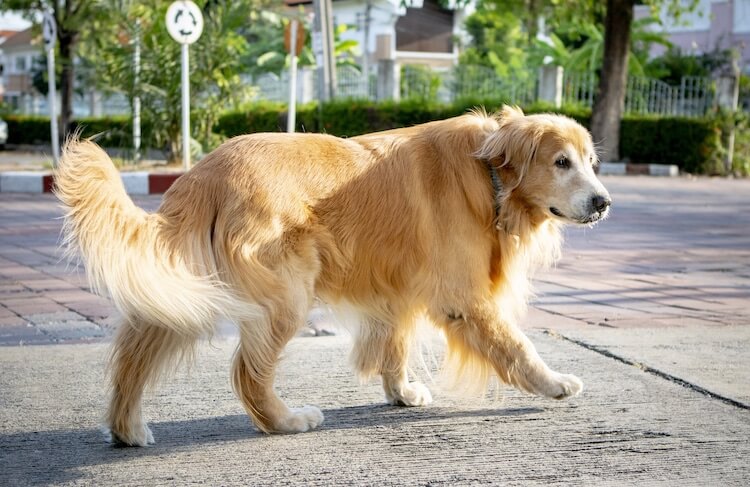
The most common idea that circulates the dog world is that a happy dog has a wagging motion. In principle this is true, but it can be a bit more complicated than that.
A wagging-tail can demonstrate positive and negative emotions. It just depends on what your dog’s usual baseline is. Cues include whether it is sitting higher or lower than normal and the speed of the wag (e.g. fast or slower and more tentative).
What Does A Dog’s Tail Position Mean
There is data which suggests the direction of the tail wag is crucial for dogs to communicate with each other
When a dog sees another canine companion wagging their tail to the right, they remain relaxed and calm. But, if they see a companion wagging to the left, they become stressed:
- Right wagging = good
- Left wagging = not so good
| Fast wag | Excited |
| Broad wag which pulls the hips with it | Happy/greeting |
| Broad wag | Friendly |
| Lower than horizontal, sometimes swings | Unconcerned |
| Half lowered with slow wag | Insecure |
| Down, near legs, legs straight, swings slowly | Pain/depressed |
| Down, near legs with legs bent to lower | Timid, wary, insecure |
| Tucked | Fearful, anxious |
| Horizontal but not stiff | Focused |
| Horizontal, pointing straight out | Challenged, may lead to aggression |
| Up and slightly over back | Confident |
To understand the emotional state of your dog, you need to understand what normal looks like first. This will largely depends on their breed and anatomy:
- Some dogs have tails which lie flat, for example a German Shepherd
- Some dogs have a curly tail as a baseline, for example a Pug, Akita or Basenji
Curly-Tailed Dogs
If they are worried, stressed or otherwise negatively aroused, their tail will drop flat. If they are running with excitement, it will often stick up like a flagpole!
Due to the curly nature of their tail, wagging isn’t always overly obvious, but there will be a small movement.
Flat-Tailed Dogs
In the example of the German Shepherd, they would wag their tail if they were positively aroused, and it would be obviously noticeable.
However, if they were negatively aroused, it would sit higher. Still likely to wag, although, it will be a slow, tentative wag.
If he was worried or stressed, it would sit low and be tucked between his legs.
3. Why Does My Dog Chase His Tail?
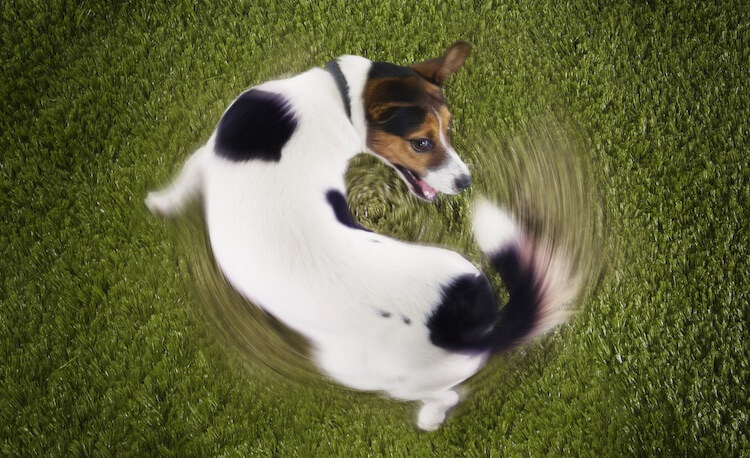
If you ask any dog owner, the common consensus when a dog chases his tail is that he is bored. But, like everything with our canine companions, there is a little more to this behavior.
Firstly, bored dogs will chase their tail. But, you will notice other bored behaviors like:
- Destruction
- Pacing
- Inappropriate Vocalizations
In most adult dogs, this behavior of chasing isn’t common. Most puppies will chase their tail and this is a completely normal behavior.
Puppies haven’t got spatial or body awareness and they just see it as something that is following them. They often don’t realize it’s attached until they attack it and then hurt themselves! Puppies are even more tempted to chase if their tail has long hair or a different colored tip.
However, puppies chase many things. How many of us have watched our puppies chase leaves in the yard? They tend to grow out of it.
Dogs May Also Have Been Accidentally Trained To Chase Their Tail
Like, a howling behavior, we often find it endearing and laughter worthy when a dog chases their tail. We provide a positive response and the dog learns that when he does it, something good happens.
When we laugh or ask them “where’s your tail?!” they continue to do so.
There is also the risk of happy-tail. When a dog with a powerful tail frequently wags it, they can hit units and walls around the home. The more a dog does this, the more likely they are to damage their tail. You may notice hair falling out or broken skin.
This is more common in dogs like Labradors and Beagles but can happen to any dog with a happy disposition and powerful wagging motion!
If your dog’s tail is becoming painful, they may be more likely to chase and lick it. If your dog is frequently doing this, they may also be suffering from intolerances and develop itchy or irritated skin.
If your dog is catching their tail and nibbling it frequently, it could be worth checking the rest of their body for irritation (paws are usually a good indicator).
4. It Can Affect Your Dog’s Toileting
A dog’s tail is an extension of a dog’s backbone.
It is full of vertebrae, depending on the breed and size of your dog, it is made up of between six and 23 highly mobile vertebrae enclosed by muscle and four to seven paired-nerves which serve the muscles.
The nerves in the tail are protected by the vertebrae but they can be damaged.
A dog’s tail that has been trapped in doors, run over, or landed on during a bad fall may have experienced trauma. Any trauma to a part of or all of their tail can result in nerve damage, which if they are responsible for toileting, can suddenly lead to incontinence.
There is also a risk of injury and trauma if it’s is pulled. Usually if the tip has been injured, it recovers well on its own.
If you notice toileting issues in your dog and a limp tail, then go and see your Veterinarian for further investigation.
5. A Dog’s Tail Can Spread Scents
A dog’s anal glands are two sacs under the tail (either side of the anus). They are filled with a liquid that is unique to each dog and have a purpose of scent glands.
As your dog defecates, they release some fluid that tells other dogs vital information about him.
When your dog wags his tail, he is wafting the odor from his anal glands into the air:
- A confident dog will usually hold their tail higher, allowing the glands to release their scent
- A more timid dog will cover their anal glands with their tail in the hope of keeping a low profile
6. Speedy Dogs Tend To Have Longer Tails
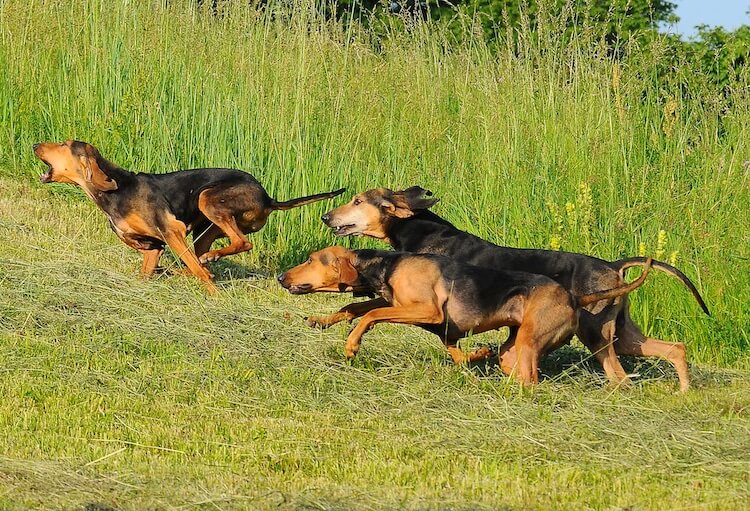
If you have ever spent time watching a greyhound or whippet, you will notice how long their tail appears to be in comparison to their body!
As a speedy dog corners, they whip it around to counterbalance their movement. This counterbalance is your dog’s way of using their tail to keep them upright under load. Unfortunately, because of their long length, speedy dogs (along with Spaniels) are more likely to suffer from injuries.
Despite the benefit a long-tail brings to keeping a speedy dog stable during cornering, many working dogs have their tail docked. This is thought to reduce the likelihood of injury or trauma. For terrier dogs, this is usually done to prevent trauma when they are digging through narrow spaces.
As we know, the tail is vital in communication between dogs and for us humans to assess their emotional state.
It has been suggested that dogs who are docked are more likely to suffer aggressive encounters based purely on social misunderstanding with other canines. Data suggests that dogs with short-tails are twice as likely to have aggressive encounters than dogs with longer-tails.
In many countries, routine and cosmetic docking is restricted, like Australia, England and Switzerland. However in the USA, docking is unrestricted.
7. Snow Dogs Use Their Tail To Keep Them Warm
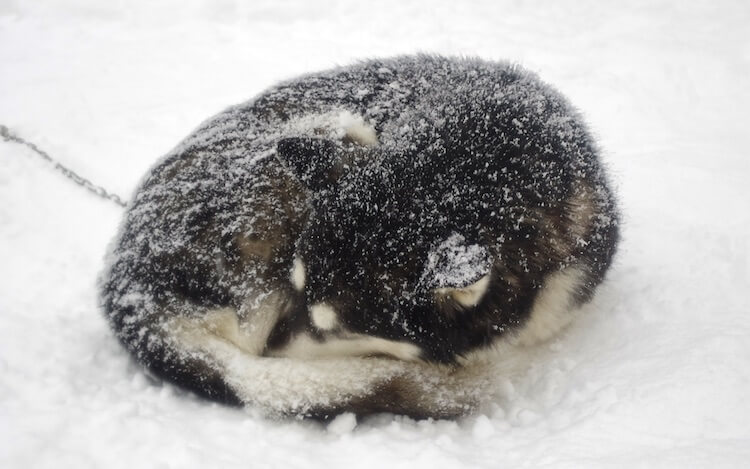
If you have had the pleasure of owning a snow dog, then you will have noticed how they wrap themselves tight into a ball and then cover their faces with their tail. This is an inherited adaptation to survive those harsh weather conditions.
Along with their double coat, their tail provides insulation.
When a dog breathes out, the air is warm from its time in the lungs. The bushy tail found on snow dogs, traps some of the warm air, creating a warmer pocket for the air breathed in to filter through.
In short, their bushy tail filters extremely cold air before it gets into the dog’s nose, to help them maintain a warm body temperature.
8. Dogs Need Their Tail For Swimming
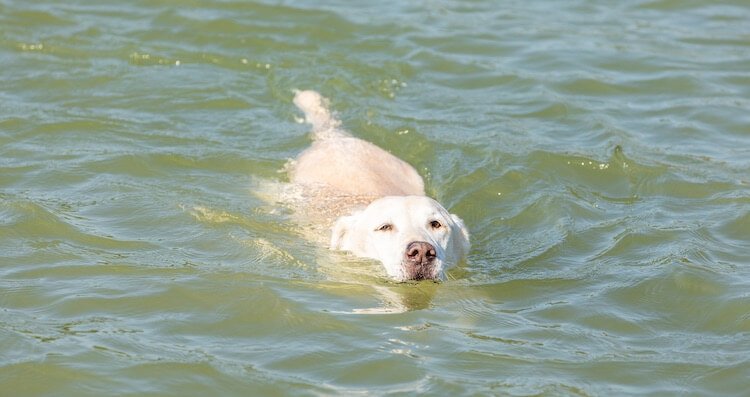
Like fast dogs use their tails for stability on land, water dogs use it as a rudder when they are swimming.
They direct their tail to help steer. When a dog is swimming, you’ll notice their tail straight out below the surface, but then as soon as you encourage them to turn, it will swing to help them change direction.
The only thing to be aware of, is that water dogs are predisposed to suffering with limber tail.
This is a muscle injury or strain and is caused by over-use. So, if your dog has spent too long swimming and they’re not used to it, it could incur limber tail (it occurs quickly and will result in a limp appearance).
Summary
Not just the tool of destruction we thought it was, a dog’s tail has a range of functions from communication to swimming and is a crucial part of their anatomy.
From helping us understand their emotional state, to letting other dogs know how they are managing stressful situations, tails are a vital communication tool for our canine companions.
They also serve helpful practical-functions, depending on the breed and whether they have a job to do:
- Snow dogs use it as insulation
- Water dogs use it to steer
- Speedy dogs need them for balance
Understanding your dog’s tail is very important as a responsible owner. They can suffer trauma and injury so always keep an eye on them. If you are concerned about any changes to their normal tail-wagging behavior, then call your local Veterinarian for further advice.




Be the first to comment